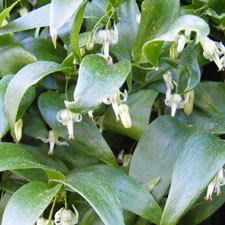 Smilax
Smilax
Common name: Smilax
Botanical name: Asparagus asparagoides
Management programme: Advisory
Originally from South Africa, Smilax is also known as bridal creeper as it has been widely used for bridal bouquets, floral arrangements and also as a plant for hanging baskets.
Why is it a pest?
- Smilax forms dense patches that smother low growing plants and seedlings. These thickets are practically impenetrable.
- It grows up and over other trees and plants.
- Tubers are tough and long-lived, re-sprouting easily.
- It is hardy and will recover from fire damage or being cut right back.
Where is it found?
- Usually found in low canopy habitats. Tolerates shade and full sun and a variety of conditions.
- Can grow happily on poor, volcanic soils, bare rock, sand, coastal and estuarine zones, and pohutukawa forests.
- It produces numerous seeds which are spread by birds. Tubers are spread by soil and water movement.
- Smilax is found throughout the Bay of Plenty.
What does it look like?
- A scrambling perennial that grows multiple, twisted, thin and wiry green stems.
- Grows to 3m. They have hooked thorns that allow them to climb other plants.
- Flowers appear July to August and are greenish-white and small (5-6mm).
- Fruit is small (6-10mm), round, red berries. Each berry contains 2-8 tiny black seeds and is rubbery in texture.
- Roots are tubers and grow in clusters. They are fleshy to the touch and white.
What are the rules?
Advisory
Council does not enforce the control of advisory species. It is landowner/ occupier responsibility to manage these pests. Council may provide advice on how to manage or control advisory species if required.
How do you get rid of it?
- Foliar spray spring to early summer (glyphosate)
- Dig out tubers.
It’s recommended to not hand pull the plants out as the stems break at ground level, leaving the tubers behind.
If you are digging, make sure you remove all of the plant. Turning over the soil with digging will expose seeds that have fallen from the parent plant. This will encourage new growth. Dispose of tubers at refuse stations in general waste.
If foliar spraying, ensure you don’t use penetrate if you are spraying against tree trunks. Spray lightly and avoid run-off.
Follow up control every six months until no new growth comes through (potentially 2-3 treatments). Seeds are not thought to be long lived, so the area can be densely planted to minimise reinvasion.
CAUTION: When using any herbicide or pesticide, PLEASE READ THE LABEL THOROUGHLY to ensure that all instructions and directions for the purchase, use and storage of the product, are followed and adhered to.
Read more on pest control advice, information and regulations.
Images







